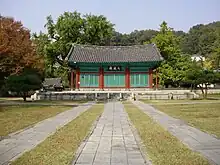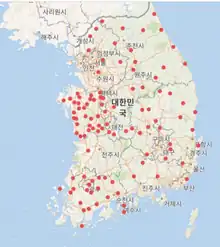| Hyanggyo | |
 Daeseongjeon Hall of Jeonju hyanggyo in Jeonju, Jeollabuk-do. | |
| Korean name | |
|---|---|
| Hangul | 향교 |
| Hanja | |
| Revised Romanization | Hyanggyo |
| McCune–Reischauer | Hyanggyo |

Hyanggyo[1] were government-run provincial Confucian schools established during the Goryeo (918–1392),[2] and Joseon (July 1392 – August 1910) periods in Korea. They were established to educate and train officials in Confucian ideals and the ethics of government. In the Joseon period, when Neo-Confucianism replaced Buddhism as the ruling ideology, the government needed to promote the new ideology to create a new social order based on Neo-Confucianism.[3] During this period also, teachers at Hyanggyo received land, royalties, and slaves from the government.[4]
They were officially closed near the end of the Joseon Dynasty, in 1894, but many were reopened as public elementary schools in 1900. They were not widely used during either period.
In the Joseon period, hyanggyo were established in every bu, mok, daedohobu, dohobu, gun, and hyeon (the last corresponding roughly to the size of modern-day cities and counties). They served primarily the children of the yangban, or ruling elite upper-class. Education was oriented toward the gwageo, or national civil service examinations. Although such education was in high demand, the hyanggyo were ultimately unable to compete with the privately run seowon and seodang.
See also
References
- ↑ "향교(鄕校) Hyanggyo". encykorea.aks.ac.kr (in Korean). Retrieved 2023-11-01.
- ↑ "철원향교(鐵原鄕校) Cheorwon Hyanggyo". encykorea.aks.ac.kr (in Korean). Retrieved 2023-11-01.
- ↑ Dong-Pyo Jang (1 January 2014), The Educational System, pp. 197–205, doi:10.1163/9789004261150_019, Wikidata Q123273355
- ↑ "면천향교(沔川鄕校) Myeoncheonhyanggyo". encykorea.aks.ac.kr (in Korean). Retrieved 2023-11-01.
- 향교 鄕校 [Hyanggyo] (in Korean). Nate / Encyclopedia of Korean Culture. Archived from the original on 2011-06-10.